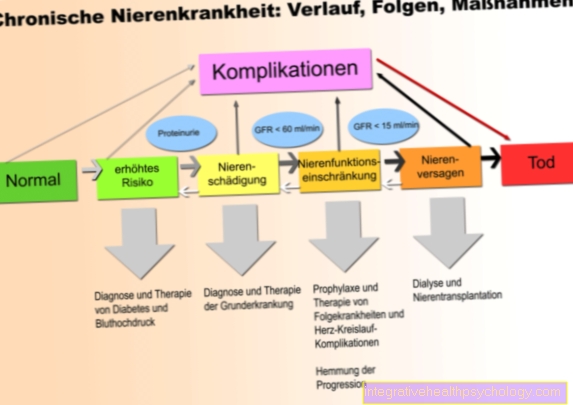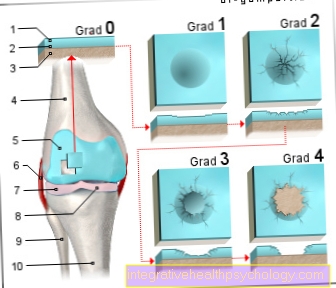Operation of a cerebral haemorrhage
introduction
A cerebral hemorrhage is a life-threatening emergency in which it comes to bleeding into the brain. But not every cerebral hemorrhage requires an operation.

On the one hand, the extent of the bleeding, i.e. the amount of blood, is decisive. Smaller hemorrhages are absorbed spontaneously and therefore resolve by themselves. Larger ones may have to be surgically removed. On the other hand, the location, i.e. where the bleeding occurred in the brain, is an important criterion. The cause of the bleeding also plays a role in treatment. If, for example, a bulging of a blood vessel (aneurysm) has burst, it often has to be treated surgically.
Indication for an operation
There are many factors that determine whether or not an operation is necessary if you have a cerebral hemorrhage. On the one hand, the cause of the bleeding is relevant. For example, is there an aneurysm (bulging of a blood vessel) as the cause of the bleeding? On the other hand, the location is crucial. A distinction is made here between bleeding that is above or below the cerebellum.
If the hemorrhage is in the cerebrum and the hemorrhage is not based on an aneurysm, then one can definitely wait and see, unless there are neurological symptoms.
If the patient's wakefulness (vigilance) is reduced or if it worsens over time, an operative intervention is advisable. Superficial bleeding (<1 cm from the surface of the brain) can also be surgically removed without major trauma to the surroundings. In the case of deep-seated bleeding in the cerebrum, people are much more reluctant to have an operation.
If the bleeding is localized near the cerebellum, the following complications can arise: There is only limited space in the bony skull, so the bruise can press on the brain tissue and damage the nerve cells. The main fear is damage to the brain stem, which can quickly lead to impaired breathing and death. The drainage of nerve fluid (liquor) can also be prevented by bleeding near the cerebellum. Therefore, one should intervene surgically if the imaging shows a congestion of the nerve water. You can also try to drain the nerve water to the outside via a tube (external ventricular drainage).
Course of the operation
The aim of the operation is to remove the bruise as completely as possible and to eliminate the cause of the bleeding. To do this, the bony skull must first be opened (= craniotomy). The neurosurgeons choose the location of the craniotomy in such a way that the doctors can get to the bleeding by the shortest route without having to damage other structures. After opening the skull, the hard meninges (dura) must also be opened and the way to the bleeding cavity must be prepared, i.e. the doctors use their instruments to penetrate the brain tissue to the location of the bleeding. If the bruise is still quite fluid, it can easily be suctioned off with a cannula. Clotted blood (clot) must be removed with so-called grasping forceps. An attempt is made to empty the bleeding cavity by irrigation and suction. In doing so, extreme care must be taken to avoid mechanical damage to the surrounding brain tissue.
If an aneurysm is the cause of the bleeding, an attempt is made to switch it off using a so-called clip or coil in order to prevent further bleeding. When the procedure is over, the skullcap is closed again and the skin incision is clamped.
Would you like to learn more about the brain aneurysm and its therapy? Then visit the page: Brain Aneurysm - Causes and Therapy
What are the risks?
Basically, before any operation, you have to weigh the benefits of the operation against its risks. Most operations after cerebral haemorrhage are emergency operations or operations without which a life-threatening condition for the patient will develop over time. In principle, complications can arise in individual cases with all surgical interventions. This is of course also the case with neurosurgical interventions.
The most important general risks are rebleeding, infections, wound healing disorders and anesthetic incidents. To operate on a cerebral haemorrhage, a hole must always be made in the bony skull. This allows germs to get in and trigger an infection. If the bleeding is not localized on the brain surface, further brain regions can be damaged by the surgical access route. This can trigger epileptic seizures or lead to paralysis and speech disorders. Therefore, the choice of the access route is considered very carefully. A team of neurosurgeons also thinks very carefully about the question of whether a surgical procedure has to be carried out at all. Not every cerebral haemorrhage has to be operated on. Older patients with previous illnesses also have an increased risk of anesthesia. This fact is also taken into account in the decision.
If you are planning to have an operation for a cerebral haemorrhage, a doctor responsible will usually explain the risks, the procedure and possible alternatives to you before the procedure.
Would you like to find out more about post-operative risks in general? Then visit our page: Postoperative Complications
What are possible consequential damages?
In principle, there can always be secondary damage after an operation on the brain. It is often the case, however, that if the bleeding spread, even worse consequential damage would develop, which one tries to avert with the operation. Especially with deeper cerebral hemorrhages, the surgeon first has to gain access to the hemorrhagic cavity, where nerve cells are inevitably damaged along the access route. This does not always result in noticeable consequential damage. If larger areas are injured, however, the typical neurological deficits such as paralysis and sensitivity disorders can occur. Difficulty speaking can also occur after the operation. Coordination and balance disorders are particularly common in operations on the cerebellum. To what extent these symptoms persist must be seen. Memory and concentration disorders are usually temporary. Epileptic seizures are also a possible complication. They can also appear some time after the operation due to scarring in the brain tissue.
What are the chances of survival after an operation?
This question can not be answered generally. How high the mortality after an operation is depends on the individual risk of the patient. Age and previous illnesses are decisive for the anesthetic risk. It is also a question of how complex the operation being performed is. Bleeding close to the surface is easier to operate than deeper bleeding with invasion of the ventricular system (= cavities in the brain with an accumulation of nerve water). In addition, one should know that the probability of dying from a cerebral hemorrhage alone is between 30 and 50%. Surgical intervention tries to improve the patient's prognosis.
You can also read about the chances of recovery after a cerebral hemorrhage: What are the chances of recovery after a cerebral hemorrhage?
How long does a cerebral haemorrhage operation take?
How long the operation of a cerebral haemorrhage lasts cannot be answered across the board. For the relatives, the duration of an operation begins with the induction of anesthesia, depending on the age and previous illnesses of the patient, this can take up to an hour. Often, access points for infusions and invasive blood pressure measurement still have to be made. So that the head remains stable during the operation, it is fixed with a frame. The head hair must be shaved off at the point where the skull is to be opened. These preparatory measures up to the incision can take 1-2 hours. The duration of the actual operation depends very much on the type of operation. Which access route is chosen? Where is the bleeding located? Is it easy to clean the bleeding cavity? Does the cause of bleeding also have to be eliminated in the form of an aneurysm (vascular sac)? This of course lengthens the procedure. Possible complications such as secondary bleeding also increase the duration of the operation. It also takes at least an hour until the patient is back in the recovery room or in the intensive care unit after the operation. While the time passes painfully slowly for the relatives in the waiting room, it must be said that even simple, uncomplicated operations on the skull take several hours. Basically, one can safely state that the following applies: the more complex the operation, the longer it takes.
You might also be interested in: Anesthesia - procedure, risks and area of application
Renewed cerebral hemorrhage after an operation
In principle, complications can arise in individual cases with every surgical procedure. One possible complication is always secondary bleeding. How severe the restrictions are for the patient depends on many factors. For example, it is crucial how much blood escapes in the head after the operation and whether the bleeding stops by itself or has to be operated on again.
What exactly is the cause of secondary bleeding?
If a small bruise forms in the operating area after the operation, this can also be harmless and be caused by the damage to smaller vessels during the operation. However, if an attempt has been made to switch off a vascular sac in the cerebral arteries (aneurysm) using a clip and postoperative bleeding occurs, a detachment of the clip can also be the cause of postoperative bleeding. If this is the case, then the bleeding is usually worse, which often leads to further surgery.
Basically, it is important that the patient is closely monitored after a neurosurgical procedure in order to quickly recognize possible complications and to be able to react appropriately to them.





























